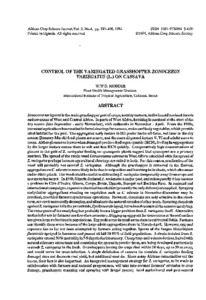| dc.description.abstract | Zonocerus variegatus is the main grasshopper pest of crops, notably cassava, in the humid lowland forests and savannas of West and Central Africa. In parts of West Africa, hatching is maximal at the start of the dry season (late September - early November), with outbreaks in November - April. From the 1950s, increased agriculture has resulted in forest clearings for cassava, maize and leafy vegetables, which provide ideal habitat for the pest. The aggregated early instars (I-III) prefer herbs off-farm, but later in the dry season (January-March) food-plants are scarce, and the more dispersed instars V, VI and adults move to crops. Although cassava leaves when damaged produce hydrogen cyanide (HCN), feeding in aggregations by the larger instars causes them to wilt and lose HCN quickly. Comparatively high concentrations of glucose in the guts of Z. variegatus feeding on cyanogenic plants suggest that cyanogens are a primary nutrient. The spread of the exotic weed Chromolaena odorata in West Africa coincided with the spread of Z. variegatus perhaps because agricultural clearings are suited to both. For this reason, eradication of the weed will probably not control Z. variegatus. Although the grasshopper is attracted to the flowers, aggregation on C. odorata is more likely to be due to oviposition and hatching in its shade, which also occur under other plants. The weed could be useful in distracting Z. variegatus temporarily away from crops and as a spraying target. In 1970, Nigeria declared Z. variegatus a major pest, and subsequently it has become a problem in Cote d'Ivoire, Ghana, Congo, Benin, Uganda, Senegal and Burkina Faso. In national and international campaigns, expensive chemical insecticides (presently the only defence) are applied. Spraying early-instar aggregations roosting on vegetation such as C. odorata in November-December may be practical, provided farmers synchronise operations. However, chemicals are only effective in the short-term, are environmentally damaging, and eliminate the natural enemies of other pests. Spraying chemicals against Z. variegatus kills the parasitoids, Epidinocarsis lopezi, introduced to control the cassava mealybug. The resurgence of the mealybug has probably been a bigger problem than Z. variegatus itself. Alternative methods for use by farmers are therefore necessary. Digging up egg pods for desiccation at the soil surface has given large reductions in populations. Egg pods occur in small areas close to cultivated fields. Farmers can identify these areas because of the large adult aggregations there in March-April. However, egg-pod exposure has so far not been attempted by farmers acting together. Spores of the fungus Metarhizillm jlavoviride sprayed in kerosene and peanut oil kill 70-95% of field populations. A strain isolated from Z. variegatus caused 90% mortality in 7-9 days in the laboratory. Cheap trap-and-release devices, baited with natural olfactory attractants and containing the spores in powder form, are being developed particularly to reach Z. variegatus in the bush. Grasshoppers leaving the traps died within 10 days, up to 30m away, and would serve for cross-infection. A single defoliation of cassava (to simulate Z. variegatus feeding damage) does not decrease root yield, but additional ones do. Since many African communities eat the leaves, their loss is also important. An integrated management strategy for Z. variegatus, to be made in collaboration with farmers and national programmes, will take into account farmers' attitudes to crop damage, grasshopper trapping and spraying with fungal spores; local agricultural and pest-control practices; and cost/benefit analyses. Chemicals will not be emphasised but habitat management, based on the grasshopper's feeding and oviposition behaviour, will be. |

